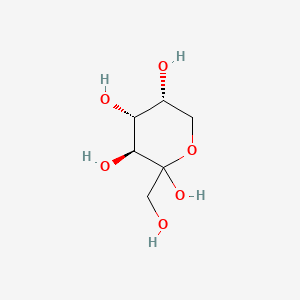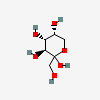D-Fructose
- fructose
- D-fructopyranose
- D-fructose
- fructopyranose
- fructopyranoside
- Create:2005-07-19
- Modify:2025-01-18


- Apir Levulosa
- Fleboplast Levulosa
- Fructose
- Levulosa
- Levulosa Baxter
- Levulosa Braun
- Levulosa Grifols
- Levulosa Ibys
- Levulosa Ife
- Levulosa Mein
- Levulosa, Apir
- Levulosa, Fleboplast
- Levulosado Bieffe Medit
- Levulosado Braun
- Levulosado Vitulia
- Levulose
- Plast Apyr Levulosa Mein
- fructose
- D-fructopyranose
- D-fructose
- fructopyranose
- fructopyranoside
- d-fructopyranoside
- D-Fru
- D-Arabino-Hex-2-ulo-Pyranose
- fru
- CHEBI:37714
- fructosteril
- laevoral
- laevosan
- levugen
- UNII-R73GS1TJE0
- HSDB 526
- Fruchtzucker
- Fruktose
- Laevulose
- Levolose
- BRN 1423189
- arabino-hex-2-ulose
- [14C]-Fructose
- 4-01-00-04402 (Beilstein Handbook Reference)
- SCHEMBL239448
- (3S,4R,5R)-2-(hydroxymethyl)oxane-2,3,4,5-tetrol
- CHEMBL2325229
- CHEBI:15824
- CHEBI:28757
- LKDRXBCSQODPBY-VRPWFDPXSA-N
- AKOS004910390
- F0317
- C05003
- TOPIRAMATE IMPURITY, FRUCTOSE-(USP IMPURITY)
- Q27117234
- EB37038E-44A6-4AF7-B0D8-47A315AD2F74
- FRUCTOSE (CONSTITUENT OF CRANBERRY LIQUID PREPARATION)
- (3S,4R,5R)-2-(hydroxymethyl)tetrahydro-2H-pyran-2,3,4,5-tetraol
59.01472 100
59.02263 67.70
43.01821 17.40
59.03278 17
41.01209 17
71.01385 100
59.0137 99.40
89.02445 83.70
113.02463 15.10
101.02439 11.60
Information on 13 consumer products that contain Fructose in the following categories is provided:
• Inside the Home
• Personal Care
2019: 10,000,000 - <50,000,000 lb
2018: 10,000,000 - <50,000,000 lb
2017: 10,000,000 - <50,000,000 lb
2016: 10,000,000 - <50,000,000 lb
Not Classified
Reported as not meeting GHS hazard criteria by 203 of 203 companies. For more detailed information, please visit ECHA C&L website.
Aggregated GHS information provided per 203 reports by companies from 2 notifications to the ECHA C&L Inventory.
Reported as not meeting GHS hazard criteria per 203 of 203 reports by companies. For more detailed information, please visit ECHA C&L website.
There are 0 notifications provided by 0 of 203 reports by companies with hazard statement code(s).
Information may vary between notifications depending on impurities, additives, and other factors. The percentage value in parenthesis indicates the notified classification ratio from companies that provide hazard codes. Only hazard codes with percentage values above 10% are shown.
IMAP assessments - D-Fructose: Environment tier I assessment
IMAP assessments - D-Fructose: Human health tier I assessment
Patents are available for this chemical structure:
https://patentscope.wipo.int/search/en/result.jsf?inchikey=LKDRXBCSQODPBY-VRPWFDPXSA-N
- Australian Industrial Chemicals Introduction Scheme (AICIS)
- CAS Common ChemistryLICENSEThe data from CAS Common Chemistry is provided under a CC-BY-NC 4.0 license, unless otherwise stated.https://creativecommons.org/licenses/by-nc/4.0/D-Fructopyranosehttps://commonchemistry.cas.org/detail?cas_rn=6347-01-9
- EPA Chemical Data Reporting (CDR)LICENSEThe U.S. Government retains a nonexclusive, royalty-free license to publish or reproduce these documents, or allow others to do so, for U.S. Government purposes. These documents may be freely distributed and used for non-commercial, scientific and educational purposes.https://www.epa.gov/web-policies-and-procedures/epa-disclaimers#copyright
- EPA Chemicals under the TSCAD-Fructosehttps://www.epa.gov/chemicals-under-tscaEPA TSCA Classificationhttps://www.epa.gov/tsca-inventory
- European Chemicals Agency (ECHA)LICENSEUse of the information, documents and data from the ECHA website is subject to the terms and conditions of this Legal Notice, and subject to other binding limitations provided for under applicable law, the information, documents and data made available on the ECHA website may be reproduced, distributed and/or used, totally or in part, for non-commercial purposes provided that ECHA is acknowledged as the source: "Source: European Chemicals Agency, http://echa.europa.eu/". Such acknowledgement must be included in each copy of the material. ECHA permits and encourages organisations and individuals to create links to the ECHA website under the following cumulative conditions: Links can only be made to webpages that provide a link to the Legal Notice page.https://echa.europa.eu/web/guest/legal-noticeFructose (EC: 200-333-3)https://echa.europa.eu/information-on-chemicals/cl-inventory-database/-/discli/details/42023
- Hazardous Substances Data Bank (HSDB)
- ILO-WHO International Chemical Safety Cards (ICSCs)
- New Zealand Environmental Protection Authority (EPA)LICENSEThis work is licensed under the Creative Commons Attribution-ShareAlike 4.0 International licence.https://www.epa.govt.nz/about-this-site/general-copyright-statement/
- EU Pesticides Database
- CCSbaseCCSbase Classificationhttps://ccsbase.net/
- ChEBID-fructopyranosehttps://www.ebi.ac.uk/chebi/searchId.do?chebiId=CHEBI:37714
- E. coli Metabolome Database (ECMDB)
- LOTUS - the natural products occurrence databaseLICENSEThe code for LOTUS is released under the GNU General Public License v3.0.https://lotus.nprod.net/D-Fructosehttps://www.wikidata.org/wiki/Q27117234LOTUS Treehttps://lotus.naturalproducts.net/
- ChEMBLLICENSEAccess to the web interface of ChEMBL is made under the EBI's Terms of Use (http://www.ebi.ac.uk/Information/termsofuse.html). The ChEMBL data is made available on a Creative Commons Attribution-Share Alike 3.0 Unported License (http://creativecommons.org/licenses/by-sa/3.0/).http://www.ebi.ac.uk/Information/termsofuse.htmlChEMBL Protein Target Treehttps://www.ebi.ac.uk/chembl/g/#browse/targets
- ClinicalTrials.govLICENSEThe ClinicalTrials.gov data carry an international copyright outside the United States and its Territories or Possessions. Some ClinicalTrials.gov data may be subject to the copyright of third parties; you should consult these entities for any additional terms of use.https://clinicaltrials.gov/ct2/about-site/terms-conditions#Use
- Consumer Product Information Database (CPID)LICENSECopyright (c) 2024 DeLima Associates. All rights reserved. Unless otherwise indicated, all materials from CPID are copyrighted by DeLima Associates. No part of these materials, either text or image may be used for any purpose other than for personal use. Therefore, reproduction, modification, storage in a retrieval system or retransmission, in any form or by any means, electronic, mechanical or otherwise, for reasons other than personal use, is strictly prohibited without prior written permission.https://www.whatsinproducts.com/contents/view/1/6Consumer Products Category Classificationhttps://www.whatsinproducts.com/
- Cosmetic Ingredient Review (CIR)
- Haz-Map, Information on Hazardous Chemicals and Occupational DiseasesLICENSECopyright (c) 2022 Haz-Map(R). All rights reserved. Unless otherwise indicated, all materials from Haz-Map are copyrighted by Haz-Map(R). No part of these materials, either text or image may be used for any purpose other than for personal use. Therefore, reproduction, modification, storage in a retrieval system or retransmission, in any form or by any means, electronic, mechanical or otherwise, for reasons other than personal use, is strictly prohibited without prior written permission.https://haz-map.com/AboutFructosehttps://haz-map.com/Agents/13687
- NORMAN Suspect List ExchangeLICENSEData: CC-BY 4.0; Code (hosted by ECI, LCSB): Artistic-2.0https://creativecommons.org/licenses/by/4.0/D-FructoseNORMAN Suspect List Exchange Classificationhttps://www.norman-network.com/nds/SLE/
- DailyMed
- DrugBankLICENSECreative Common's Attribution-NonCommercial 4.0 International License (http://creativecommons.org/licenses/by-nc/4.0/legalcode)https://www.drugbank.ca/legal/terms_of_use
- Therapeutic Target Database (TTD)
- ECI Group, LCSB, University of LuxembourgFructose
- Natural Product Activity and Species Source (NPASS)
- Japan Chemical Substance Dictionary (Nikkaji)
- KEGGLICENSEAcademic users may freely use the KEGG website. Non-academic use of KEGG generally requires a commercial licensehttps://www.kegg.jp/kegg/legal.html
- MassBank of North America (MoNA)LICENSEThe content of the MoNA database is licensed under CC BY 4.0.https://mona.fiehnlab.ucdavis.edu/documentation/license
- Metabolomics Workbench
- National Drug Code (NDC) DirectoryLICENSEUnless otherwise noted, the contents of the FDA website (www.fda.gov), both text and graphics, are not copyrighted. They are in the public domain and may be republished, reprinted and otherwise used freely by anyone without the need to obtain permission from FDA. Credit to the U.S. Food and Drug Administration as the source is appreciated but not required.https://www.fda.gov/about-fda/about-website/website-policies#linking
- NCI Thesaurus (NCIt)LICENSEUnless otherwise indicated, all text within NCI products is free of copyright and may be reused without our permission. Credit the National Cancer Institute as the source.https://www.cancer.gov/policies/copyright-reuseNCI Thesaurushttps://ncit.nci.nih.gov
- NIPH Clinical Trials Search of Japan
- NLM RxNorm TerminologyLICENSEThe RxNorm Terminology is created by the National Library of Medicine (NLM) and is in the public domain and may be republished, reprinted and otherwise used freely by anyone without the need to obtain permission from NLM. Credit to the U.S. National Library of Medicine as the source is appreciated but not required. The full RxNorm dataset requires a free license.https://www.nlm.nih.gov/research/umls/rxnorm/docs/termsofservice.html
- Rhea - Annotated Reactions DatabaseLICENSERhea has chosen to apply the Creative Commons Attribution License (http://creativecommons.org/licenses/by/4.0/). This means that you are free to copy, distribute, display and make commercial use of the database in all legislations, provided you credit (cite) Rhea.https://www.rhea-db.org/help/license-disclaimer
- SpectraBase
- Springer Nature
- Thieme ChemistryLICENSEThe Thieme Chemistry contribution within PubChem is provided under a CC-BY-NC-ND 4.0 license, unless otherwise stated.https://creativecommons.org/licenses/by-nc-nd/4.0/
- WHO Anatomical Therapeutic Chemical (ATC) ClassificationLICENSEUse of all or parts of the material requires reference to the WHO Collaborating Centre for Drug Statistics Methodology. Copying and distribution for commercial purposes is not allowed. Changing or manipulating the material is not allowed.https://www.whocc.no/copyright_disclaimer/
- WikidataD-fructopyranosehttps://www.wikidata.org/wiki/Q27117234
- Wikipedia
- Medical Subject Headings (MeSH)LICENSEWorks produced by the U.S. government are not subject to copyright protection in the United States. Any such works found on National Library of Medicine (NLM) Web sites may be freely used or reproduced without permission in the U.S.https://www.nlm.nih.gov/copyright.htmlSweetening Agentshttps://www.ncbi.nlm.nih.gov/mesh/68013549
- PubChem
- GHS Classification (UNECE)GHS Classification Treehttp://www.unece.org/trans/danger/publi/ghs/ghs_welcome_e.html
- Glycan Naming and Subsumption Ontology (GNOme)GNOme
- MolGenieMolGenie Organic Chemistry Ontologyhttps://github.com/MolGenie/ontology/
- PATENTSCOPE (WIPO)SID 403458617https://pubchem.ncbi.nlm.nih.gov/substance/403458617



